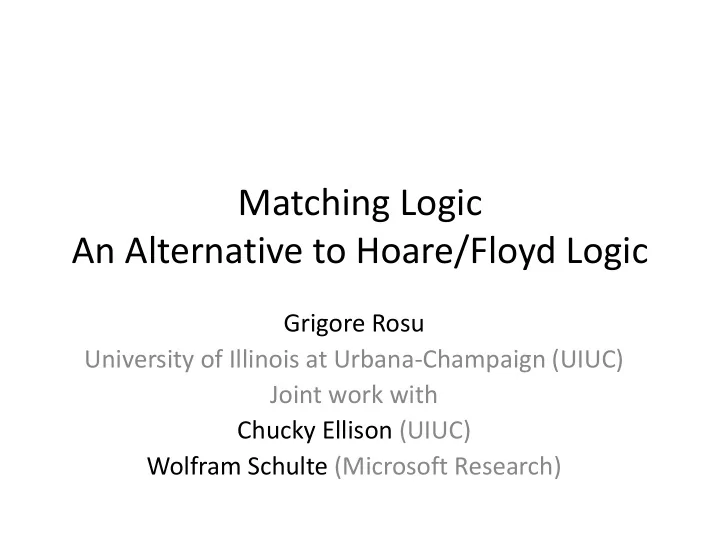

Matching Logic An Alternative to Hoare/Floyd Logic Grigore Rosu University of Illinois at Urbana-Champaign (UIUC) Joint work with Chucky Ellison (UIUC) Wolfram Schulte (Microsoft Research)
How It Started • NASA project runtime verification effort – Use runtime verification guarantees to ease the task for program verification • Thus, looked for “off -the- shelf” verifiers – Very disappointing experience …
Our Little Benchmark Reversing of a C list: if x points to a lists at the beginning, then p points to its reverse at the end We were willing p = 0; to even annotate while(x != 0) { the program y = *(x + 1); *(x + 1) = p; p = x; x = y; }
Current State of the Art • Current program verifiers are based on Hoare logic (and WP), separation logic, dynamic logic • Hoare-logic-based – Caduceus/Why, VCC, HAVOC, ESC/Java, Spec# – Hard to reason about heaps, frame inference difficult; either (very) interactive, or very slow, or unsound • Separation-logic-based – Smallfoot, Bigfoot, Holfoot* (could prove it! 1.5s), jStar – Very limited (only memory safety) and focused on the heap; Holfoot, the most general, is very slow
Current State of the Art … therefore, we asked for professional help: Wolfram Schulte (Spec# and other tools)
Do we Have a Problem in what regards Program Verification? • Blame is often on tools, such as SAT/SMT solvers, abstractions, debuggers, static analyzers, slow computers, etc., • … but not on the theory itself, Hoare/Floyd logic – and its various extensions • Do we need a fresh start, a different way to look at the problem of program verification?
Overview • Hoare/Floyd logic • Matching Logic • Short Demo • Relationship between Matching Logic and Hoare Logics • Conclusion and Future Work
Hoare/Floyd Logic • Assignment rules – Hoare (backwards, but no quantifiers introduced) – Floyd (forwards, but introduces quantifiers)
Hoare/Floyd Logic • Loop invariants • Minor problem: does not work when e has side effects; those must be first isolated out
Hoare/Floyd Logic Important observation Hoare/Floyd logic, as well as many other logics for program verification, deliberately stay away from “low - level” operational details, such as program configurations … missed opportunity
What We Want • Forwards – more intuitive as it closely relates to how the program is executed; easier to debug; easier to combine with other approaches (model checking) • No quantifiers introduced • Conventional logics for specifications, say FOL • To deal at least with existing languages and language extensions – E.g., Hoare logic has difficulty with the heap; separation logic only deals with heap extensions
Overview • Hoare/Floyd logic • Matching Logic • Short Demo • Relationship between Matching Logic and Hoare Logics • Conclusion and Future Work
Matching Logic • Inspired from operational semantics – Program configurations play an important role • Specifications: special FOL = formulae, patterns • Configurations match patterns • Patterns can be used to 1. Give an axiomatic semantics to a language, so that we can reason about programs 2. Define and reason about patterns of interest in program configurations
Program Configurations (no heap) • Simple configuration using a computation and an environment • Example
Program Configurations (add heap) • Add a heap to the configuration structure: • Example
Complex Program Configuration The CHALLENGE Language (J.LAP 2010)
Patterns • Configuration terms with constrained variables configuration term with variables constraints constraints configuration term with variables
Pattern Matching • Configurations match ( ) patterns iff they match the structure and satisfy the constraints
What Can We Do With Patterns? 1. Give axiomatic semantics to programming languages, to reason about programs – Like Hoare logic, but different 2. Give axioms over configurations, to help identify patterns of interest in them – Like lists, trees, graphs, etc.
1. Axiomatic Semantics - follow the operational semantics - • Partial correctness pairs: • Assignment • While
2. Configuration Axioms • For example, lists in the heap: • Sample configuration properties:
Overview • Hoare/Floyd logic • Matching Logic • Short Demo: http://fsl.cs.uiuc.edu/ml • Relationship between Matching Logic and Hoare Logics • Conclusion and Future Work
Overview • Hoare/Floyd logic • Matching Logic • Short Demo • Relationship between Matching Logic and Hoare Logics • Conclusion and Future Work
Matching Logic vs. Hoare Logic • Hoare logic is equivalent to a fragment of matching logic over simple configurations containing only code and an environment: • Thus, any proof derived using Hoare logic can be turned into a proof using matching logic. The opposite not necessarily true
Matching Logic vs. Hoare Logic Idea of the two transformations: – Take FOL formulae into configuration fragments x ?x , … env [ ?x / x , …] form – Take configuration fragments x ?x , … env form into FOL formulae x = ?x …
Overview • Hoare/Floyd logic • Matching Logic • Short Demo • Relationship between Matching Logic and Hoare Logics • Conclusion and Future Work
Concluding Remarks • Matching logic is derived from operational semantics; it builds upon configurations • Forwards, can be regarded as a formula- transforming approach. Not the only one: – Floyd rule also forwards – Evolving specifications (Especs: Pavlovic & Smith) – Dynamic logic (Key project – Schmitt etal.) • Distinctive feature: patterns as symbolic constrained configurations. No artificial “logical encodings” of PL -specific structures needed
Current and Future Work • Formal rewrite semantics of C (almost finished the complete language definition) • Using it for runtime analysis of memory safety and for model checking • To be turned into a matching logic program verifier for C – First steps already taken: MatchC – Can already be used to prove several runtime verified programs correct
Recommend
More recommend